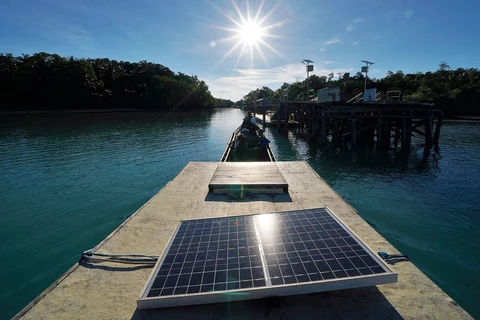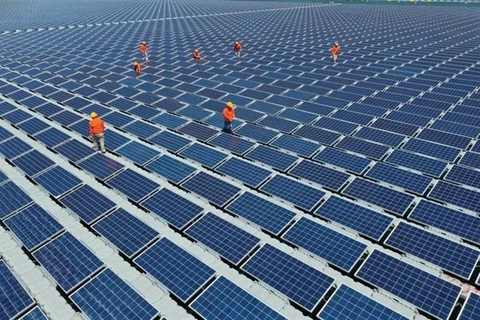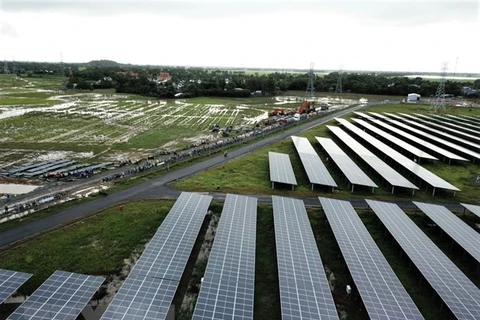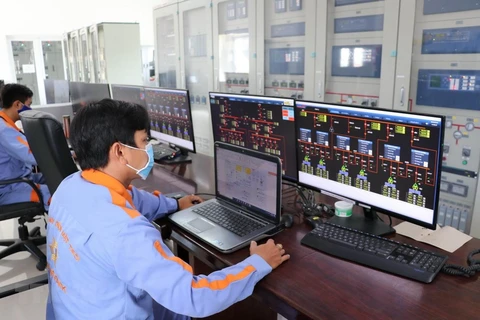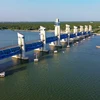Da Nang (VNS/VNA) - Central Da Nang City’s Department of Industry and Trade has launched a pilot project on the development of a million green roof-top solar power houses.
Vice director of the department Nguyen Thi Thuy Mai said the first 45 households in the city would join the project on roof-top solar power with capacities from 1.8 kilowatt peak (Kwp) to 3KWp in 2020.
She said each household with under 3KWp solar power system would receive 2 million VND (87 USD) support for each KWp from the project.
The project, which was jointly developed with the centre for Green Innovation Development (Green ID), aims to raise potential solar power in the city and reduce carbon emissions.
According to the city’s power corporation, more than 1,000 roof-top solar power projects, of which 52 percent are residential buildings, have been built in the city, supplying 1.7 million KWh to the city’s grid each year.
It said more new projects with a total capacity of 5,000 KWp would be built in the city by the end of this year.
At least 7 billion VND (304,000 USD) had been paid for local solar roof-top systems, including residential and public buildings, as well as factories at industrial parks following solar power contracts between power corporations and households.
Statistics from the department showed that Da Nang has great renewable energy potential, with 2,000 hours of sunlight per year and an estimated 1,140 MW (Megawatts) of solar power.
About 30 percent of the city’s population use solar power for water heaters, while about 20 five-star hotels and resorts are using a solar power water heating system.
Da Nang, in cooperation with the European Union, launched a pilot project to develop solar energy at two hospitals, two schools and six households and build a database of solar power capacity in the city as well as a policy framework for clean energy development.
The city plans to build a 4.4MW solar farm on the closed Khanh Son Landfill to supply 7.7 million kWh per year to the city’s power grid, while reducing 5,000 tonnes of carbon emissions each year.
The development of renewable energy projects from ocean waves, tides and biogas from rural areas is planned for 2025./.
Vice director of the department Nguyen Thi Thuy Mai said the first 45 households in the city would join the project on roof-top solar power with capacities from 1.8 kilowatt peak (Kwp) to 3KWp in 2020.
She said each household with under 3KWp solar power system would receive 2 million VND (87 USD) support for each KWp from the project.
The project, which was jointly developed with the centre for Green Innovation Development (Green ID), aims to raise potential solar power in the city and reduce carbon emissions.
According to the city’s power corporation, more than 1,000 roof-top solar power projects, of which 52 percent are residential buildings, have been built in the city, supplying 1.7 million KWh to the city’s grid each year.
It said more new projects with a total capacity of 5,000 KWp would be built in the city by the end of this year.
At least 7 billion VND (304,000 USD) had been paid for local solar roof-top systems, including residential and public buildings, as well as factories at industrial parks following solar power contracts between power corporations and households.
Statistics from the department showed that Da Nang has great renewable energy potential, with 2,000 hours of sunlight per year and an estimated 1,140 MW (Megawatts) of solar power.
About 30 percent of the city’s population use solar power for water heaters, while about 20 five-star hotels and resorts are using a solar power water heating system.
Da Nang, in cooperation with the European Union, launched a pilot project to develop solar energy at two hospitals, two schools and six households and build a database of solar power capacity in the city as well as a policy framework for clean energy development.
The city plans to build a 4.4MW solar farm on the closed Khanh Son Landfill to supply 7.7 million kWh per year to the city’s power grid, while reducing 5,000 tonnes of carbon emissions each year.
The development of renewable energy projects from ocean waves, tides and biogas from rural areas is planned for 2025./.
VNA

